The office of Harry Ryan was the place Jack London penned his seminal novel “the Call of the Wild,” about a dog that’s taken from the Santa Clara Valley to the Klondike, where he befriends wolves and leads a sled team.
Ryan, who met London through trade union activism, chose to name his 140-acre mountain ranch—in the Lexington Hills—after the classic American work of fiction.
Over the years it morphed from a retreat called “Call of the Wild Ranch and Sawmill” to the site of seasonal residences called “Call of the Wild Summer Resort & Subdivision.”
The South Pacific Coast Railroad also attempted to capitalize on London’s notoriety, naming a stop servicing Ryan’s development “Call of the Wild.”
It fell into disrepair and was abandoned following the onset of the Great Depression.

Sidney French bought a place in the Call of the Wild area with her boyfriend in 1989, the week before calamity struck. Tomorrow she turns 69Today’s her 69th birthday.
“We lost our house to the Loma Prieta earthquake,” she said, explaining four homes in the neighborhood were destroyed.
In the aftermath, she fell into the job of organizing a group water system.
“I was charged with investigating all the easements and permits,” she said. “You have to jump through these hoops.”
That’s how she came across some weird discrepancies with official records, and also when she started to feel the friction with Santa Clara County.
“I was getting all this pushback,” she said.
There was one house that jumped out at her—22150 Mineral Springs. It was built by Charles R. Cheatham, and didn’t appear to have a required geological study.
“I never saw the septic plan, because there was no septic plan,” she said. “Somehow it all happened magically because the building official gave him a Certificate of Occupancy.”
The house was sucking from the water line of a second house, which she would later purchase, after giving up on rebuilding the one destroyed in the quake.
She lives alone now at 22155 Mineral Springs Way, which no longer has liquid siphoned off, since the house across the road was finally forced to get its own intake.
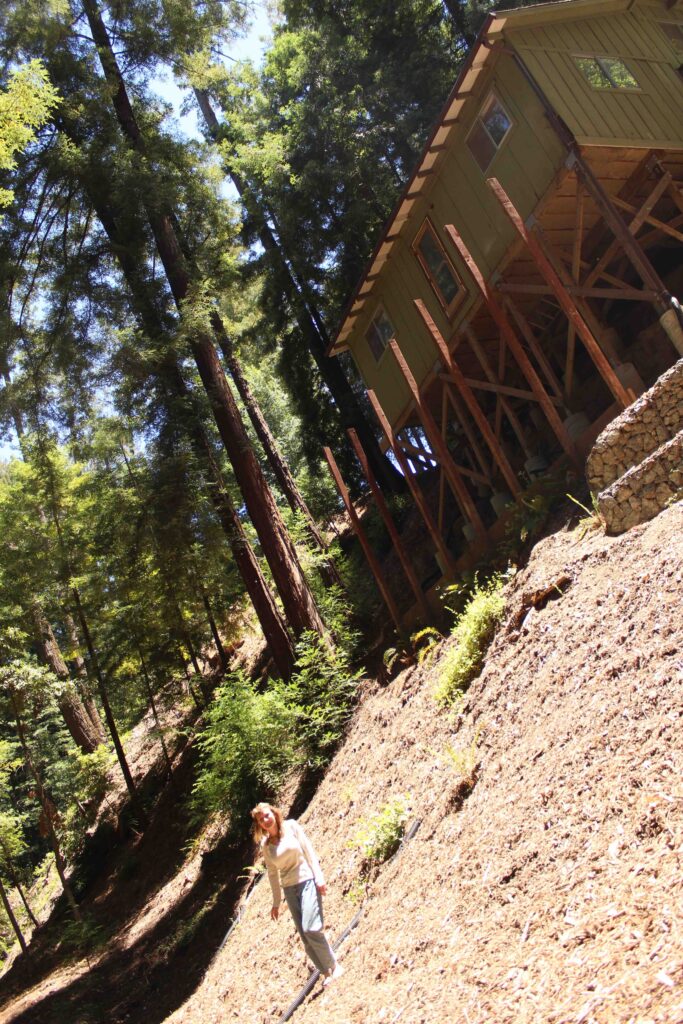
Digging through the bureaucracy
French’s problems with the County have only worsened over the years. The more digging she does, the more problems she uncovers.
She says it feels as if she’s aged a half-decade in the past year, trying to wade through the bureaucratic mire.
That’s because the house she lives in is falling apart, and the County refuses to let her work on it. The front wall is currently being stabilized by two-by-fours.
During the storm that sparked the CZU Lightning Complex fire in 2020, a bolt of lightning struck a tree near her house, sending a 35-foot section right onto her roof.
She’s up against the clock, as the two-year deadline to access insurance funds for repairs approaches.
Deanne Everton, the executive director of Rebuilding Together Silicon Valley, said their organization tried to help with other repairs, but was told to stop until paperwork problems could be cleared up.
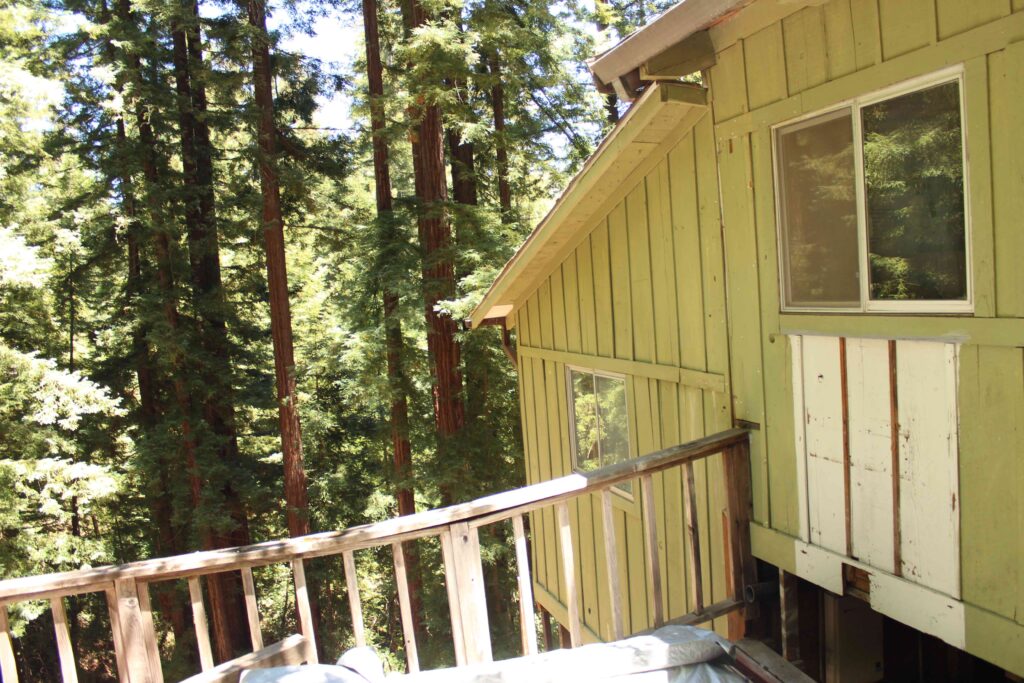
French was kicked off her insurance earlier this year because she couldn’t get a permit to remove a rickety deck.
The County sent the Los Gatan a document that claims French’s house was “rebuilt without permits” and says she’ll be on the hook for up to $3,500 per day in penalties for each of eight violations. The letter, signed by Code Enforcement Program Manager James Stephens, threatens to prosecute French in criminal court and set a July 15 deadline.
“I cry all the time,” French said. “Where am I gonna go? This is my investment.”
She’s the one who’s been taking the initiative to sort out problems created by building authorities with some whiteout and the stroke of a writing utensil. Literally.
The County’s records for the parcels in question are a mess of unsigned permits and lines through addresses that can’t seem to agree with one another.
For example, there are two slightly different versions of a document addressed to the County’s Chief Building Official, dated July 12, 1984.
And Building Violation Log 97051, from 1997, claims that 22155 Mineral Spring Way (where French now lives) “was rebuilt w/o permits.” It also states that “orig. cabin was demoed.” Just down the hill from French’s house are the remains of another structure that was destroyed in the Lexington Fire; she wonders if this confused inspector Michael Harrison when he visited the property on March 10 that year—or if he was thinking of the newer 22150 property across the road that was built from scratch by Cheatham.
Rick Matteson, a neighbor who lives on Pine Ridge Way, says French’s cabin was standing when he and his wife bought their home in 1980.
“Charles Cheatham had acquired the property, and after remodeling work sold the house to Richard Vaughn,” he wrote in a signed letter. “In 1984 Charles Cheatham also built a new large home on the vacant land to the south side of Mineral Spring Way—22150 Loma Prieta Way. He Illegally hooked this new house into the shared water system which also serves my home, and then sold the property. The water connection remained illegal until 1990 when resolved by a subsequent owner.”
In an interview with the Los Gatan, another neighbor, Kathy Wysuph, said French’s 22155 cabin was never torn down. (A pair of signs in their yard attests the “Wacky Wysuph Farm” was “established” in 1976.) In fact, her husband told building officials so in a letter supporting French.
“I feel bad,” she said. “I hope it turns out well for her.”
These days, French is employed part-time doing office and real estate research, and gets a small amount of income from Social Security. It costs her $400 a month to keep her house warm in winter with her 1964 plug-in 5,000-watt electric heater.
“At some point I don’t want to have to work,” she said, adding it’s hard to dedicate herself to making a living given the hassles brought on by the County’s series of paperwork snafus. “I spend all my time on the computer trying to deal with this.”
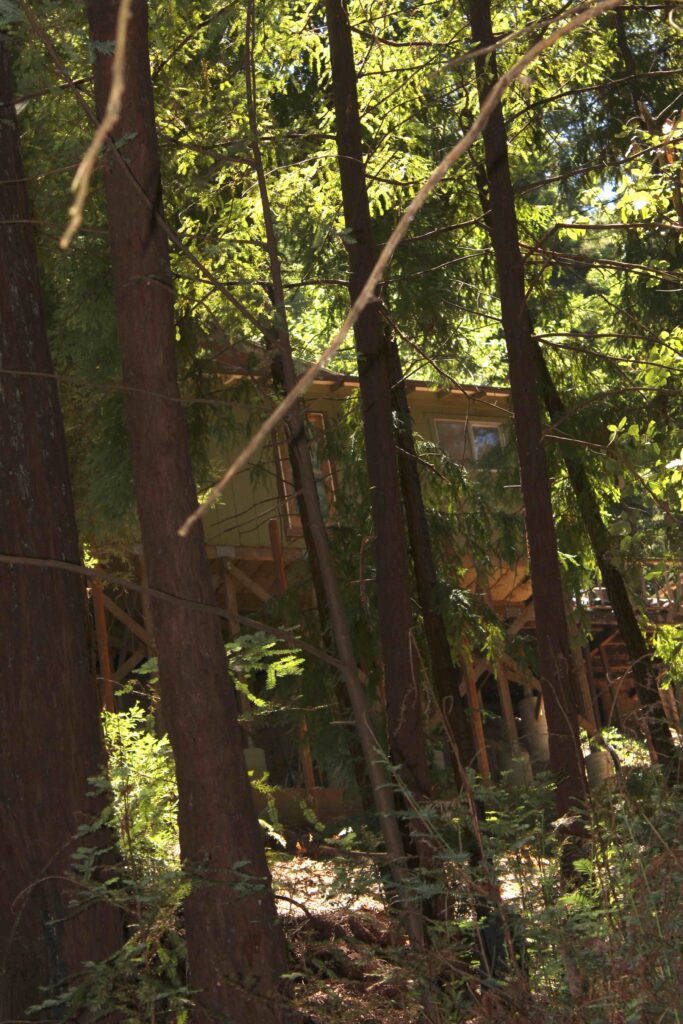
‘Bunch of mistakes’
Barry Mangan is a 73-year-old lawyer who gave up the “bad habit” of litigation 20 years ago. He met French at Calvary Church in Los Gatos, and although he’s semi-retired, he offered to try to help her rectify her property issues.
Now, his dining room table is submerged in papers—search records, parcel maps and letters—as he attempts to assist French in getting Santa Clara County’s attention.
“They have taken a very rigid administrative approach,” he said. “They have just circled the wagons and taken a position in complete opposition to the facts.”
Had French not done all that water rights research after the earthquake, she wouldn’t have a leg to stand on, Mangan points out.
“Sidney was lucky to have obtained permits before they were altered, because she was doing work on a Red Cross grant,” he said. “That all had to do with the reconstruction of the water system.”
This has led to a scenario where the Los Gatan has been able to get copies of documents the County says it’s no longer able to locate.
“The problem is they don’t want to admit that one of their own was in cahoots with Cheatham, the developer,” he said, referring to a new house that was built across the road from where French’s place. “They used rebuild permits to hide the fact that there were no permits whatsoever for the house.”
The smoking gun, he says, is in a pair of 1990 letters sent by chief building official Thomas Shih to Bob Melnikoff at the Los Gatos office of Fox & Carskadon, a real estate firm later acquired by Coldwell Banker.
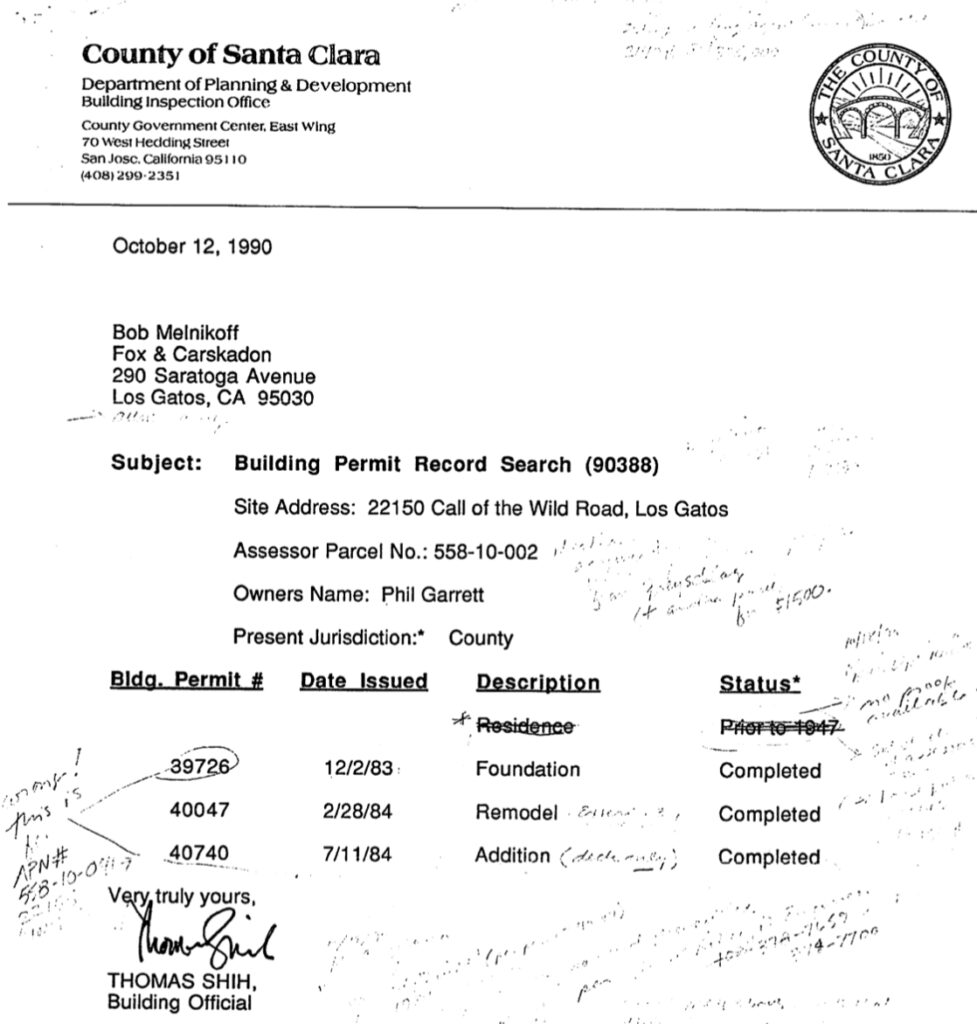
The Oct. 12, 1990 “Building Permit Record Search” for “22150 Call of the Wild Rd.” lists Permits 39726, 40047 and 40740, for foundation, “Remodel,” and addition work, respectively.
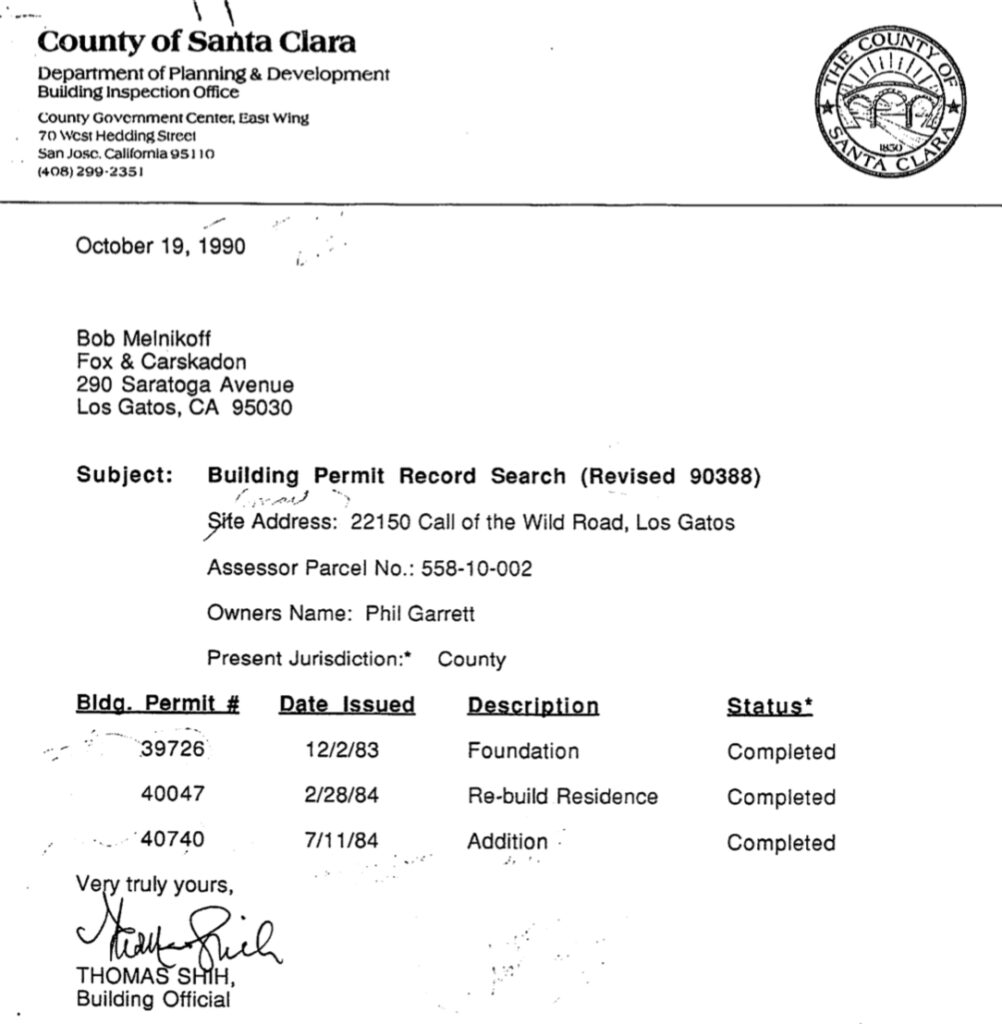
Just a week later, on Oct. 19, Shih sent over a revised building permit search for the same property.
But the description on Permit 40047 has been changed from “Interior Remodel” to “Re-build Residence.”
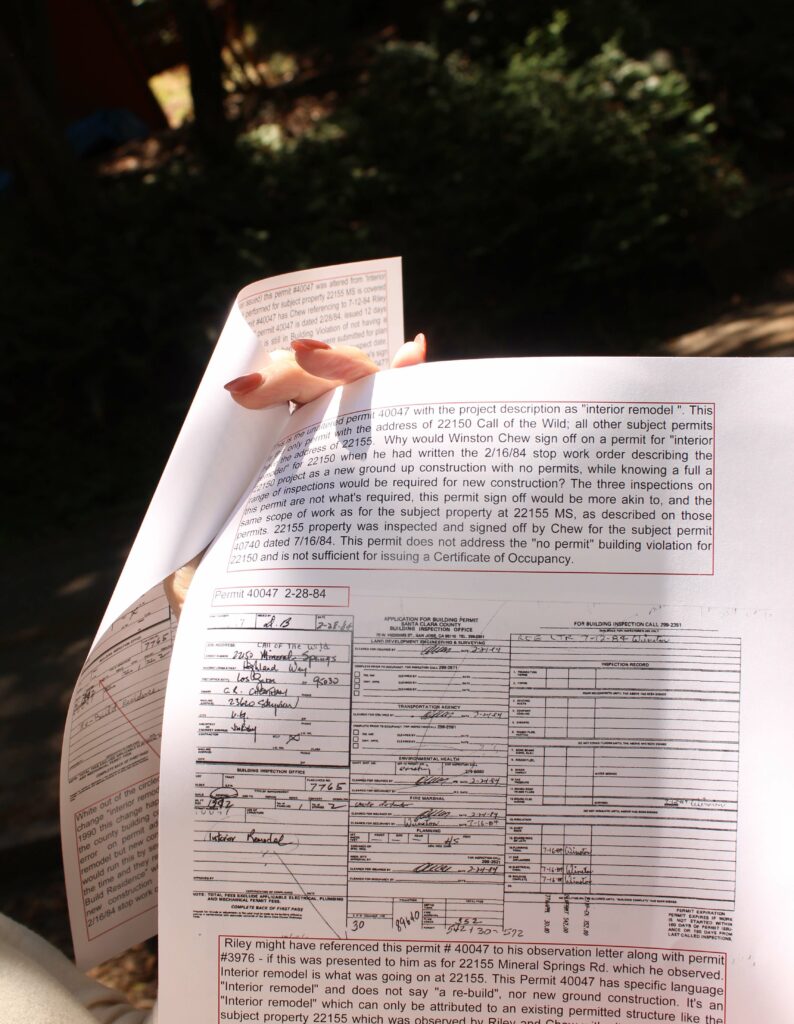
Here’s how it went down, according to French.
She’d already been to the County office and copied two permits (39726 and 40740) connected to the cabin, which Richard Vaughan had acquired from Cheatham in 1987.
Meanwhile, she’d asked Fox & Carskadon to do the official Building Permit Record Search for the new house across the street at “22150 Call of the Wild Rd.” But that also turned up 39726 and 40740—as well as 40047.

“I’m going, ‘Wait a minute; that isn’t right,’” she said, recalling what she told the building department Oct. 18 that year while piecing things together. “’There’s a bunch of mistakes on this.’”
French says the woman who was assisting her said she’d have to escalate the matter to her boss—Thomas Shih.
So, on Oct. 19, 1990, the whited-out Permit 40047 emerges, as does the Certificate of Occupancy for 22150.
French says she launched a separate California Public Records Act request this year in hopes of helping County officials locate the originals, so they could rely on their own documentation, not her copies.
“While Ms. French has made several duplicative CPRA requests to the County, we have provided her with all responsive documents and have so informed her,” a spokesperson told the Los Gatan in a statement. “Although Ms. French asserts that the County possesses additional documents, staff has been unable to locate any such documents and has repeatedly responded to her requests with that information.”
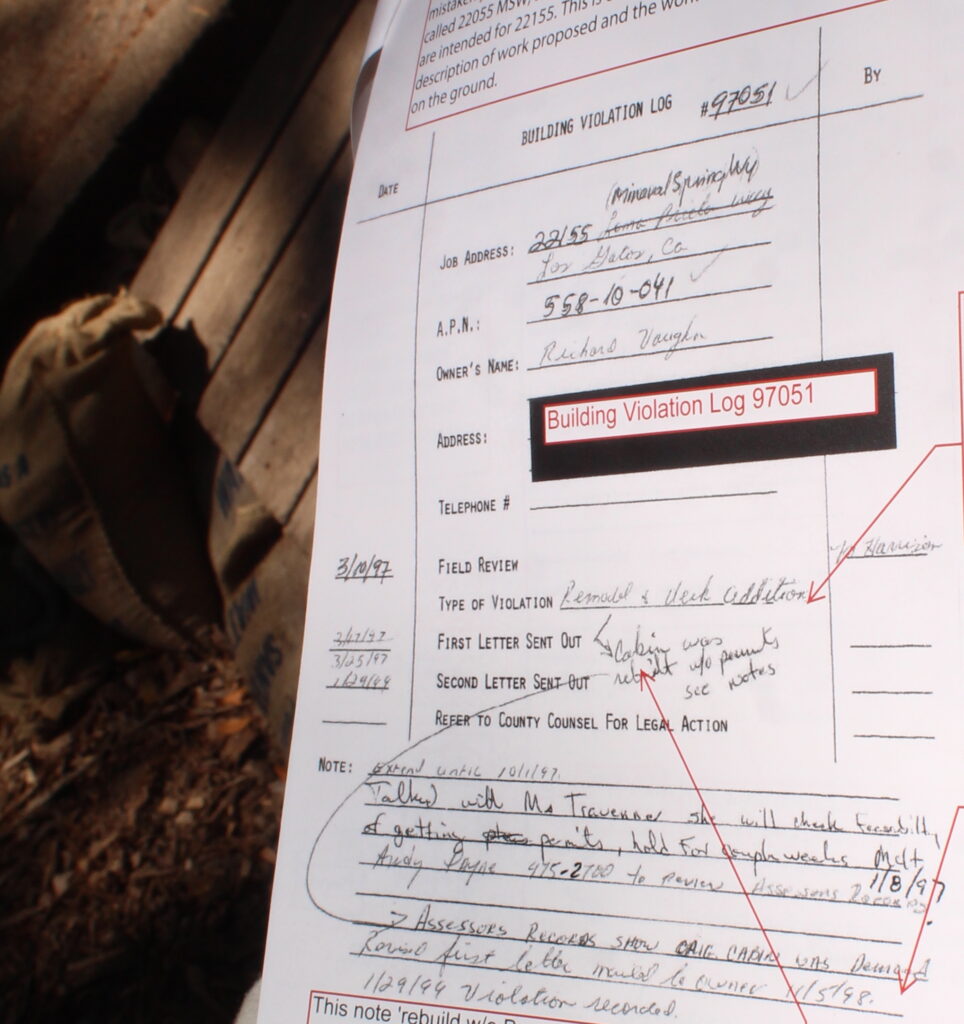
The County did not make anyone available for an interview, and maintains it’s French who is in violation of the Building Code, referring mainly to her efforts to patch-up her house after natural disasters. French says she’s only out of compliance because the County is so dead-set on covering its tracks. A rep for Supervisor Joe Simitian said he was unavailable for an interview and declined to provide a statement.
The County told the Los Gatan it met with French on multiple occasions to come up with a solution. French says it was just once.
“She’s going to lose the house, that’s what’s going to happen,” Mangan said, adding it’s all because the County won’t fess up to the permit-fudging of the ‘80s and ‘90s. “When I say misappropriating, I mean it. They took permits that belong to the cabin.”
Mangan says there’s a simple solution—return the permits to French’s file, stop pretending her home was rebuilt and issue some kind of variance for the new house at 22150.

Web of permits
Charles Cheatham claims inspector Winston Chew stood him up twice while he was attempting to bring power to the cabin at 22155.
So, he says, he went over Chew’s head and got Shih to push the permit through.
“I went in and walked back to Tom’s office, and I said, ‘Tom, all Winston has to do is come out and look at it, and he is not doing it,’” he recalled. “Tom said, ‘Give me the permit,’ and he signed it off.”
It’s unclear what permit this story relates to. Cheatham thinks the episode took place around 1982; he swears he only ever pulled one permit for the cabin.
There’s a permit French uncovered last year for her house showing electrical wiring and service work was approved in 1979, before Cheatham bought it.
Cheatham got a permit on Dec. 12, 1983 for the property across the street (Permit 39726) to repair a damaged floor under an “existing residence.”
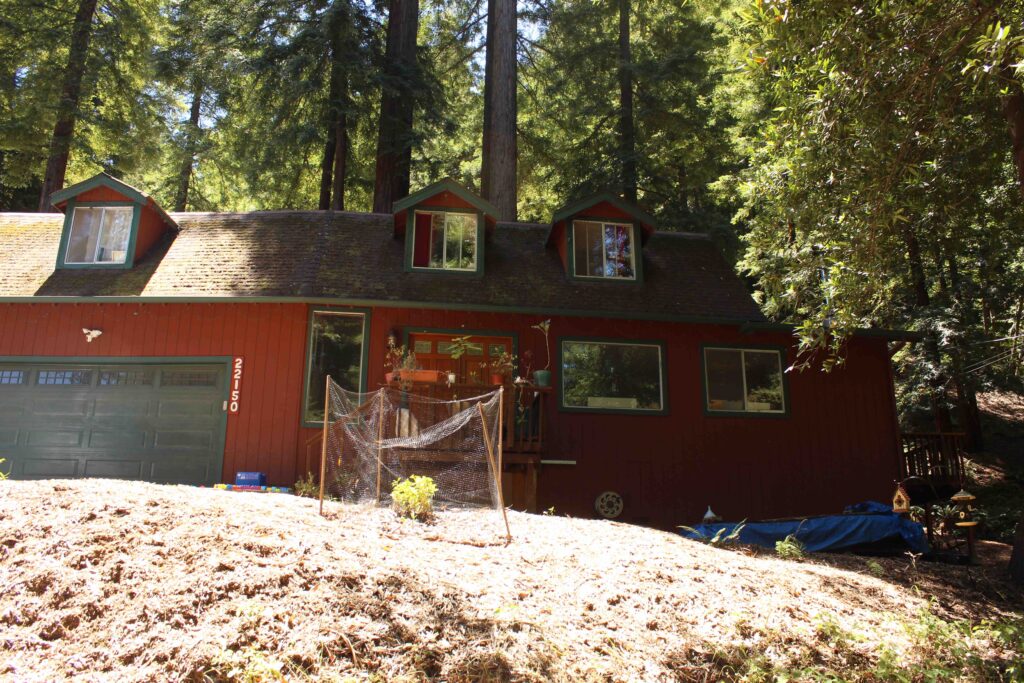
And on Feb. 15, 1984, he got a “supplemental permit” connected to Permit 39726 for a “complete re-wire” job—which French also only discovered last year, during her public records hunt.
The scene was set for Chew’s arrival on the property of the new house at 22150.
He issued a Stop Work order for the dwelling that had popped up illegally.
“I’m busted,” Cheatham remembers thinking. “The reality is, I couldn’t argue with it.”
The two-story building was “new from ground up,” records the order, dated Feb. 16, 1984.
Cheatham says he first tried to play down the violations, claiming he’d only made minor changes to an existing structure.
Cheatham says he was forced to get two extra permits and was so mad he went down to the County office and complained—and ended up getting his money back.
“The County has their head up their ass,” he said. “They don’t even know the difference between those two houses.”
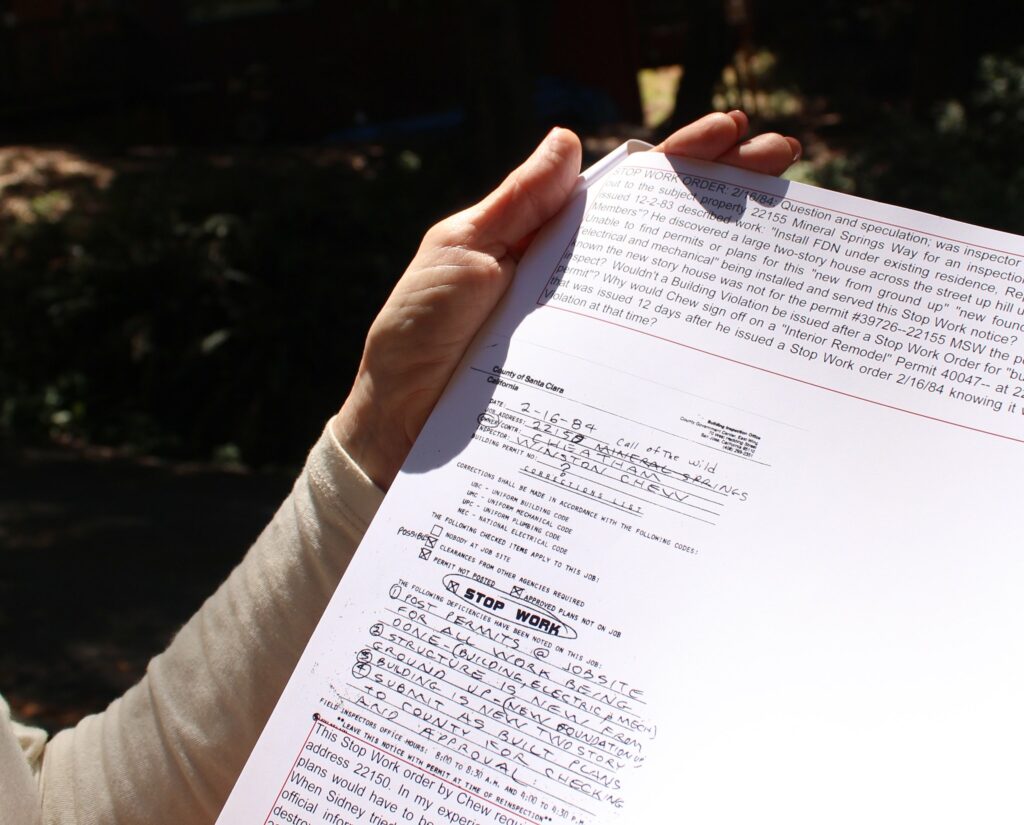
After Chew issued the Stop Work order, Cheatham had his engineer, Jim Riley, write a letter to Shih, saying foundations, plumbing, framing, roofing, electrical and other work had all been completed to code. A handwritten addition by Riley in the left margin lists permits 39726 and 40740.
This July 12, 1984 engineering approval, for 22155 Mineral Springs Road, seems to refer to the cabin French now lives in. The permit connected to it is 40740: another permit (approved a day earlier) with a “5” apparently written over the “0” at the end. And it references 40047, the third permit.
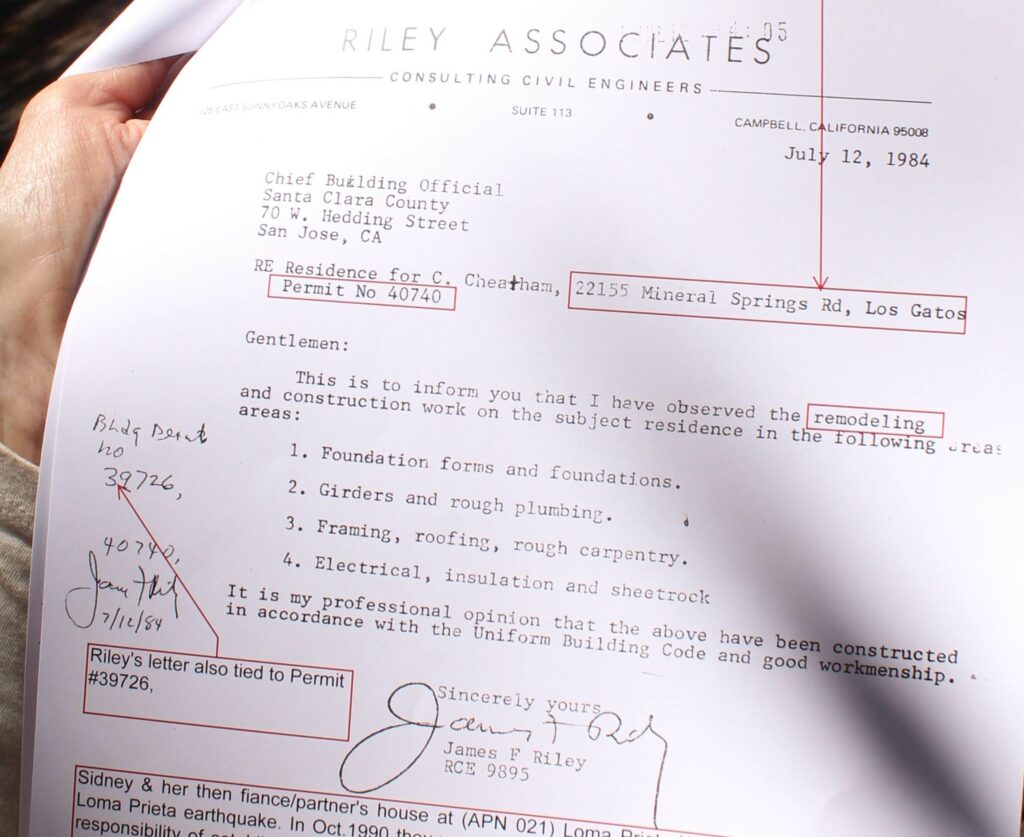
40047 was approved Feb. 28, 1984, and is clearly for “22150” (although initially listed as “Mineral Springs,” which was crossed out with “Call of the Wild” written above).
It’s also the permit that was initially for an “Interior Remodel,” then later whited-out to morph into a “Re-Build Residence” permit.

Cheatham remembers how he directed his engineer to get around the Stop Work order, back in 1984.
“Jim Riley hooked me up with somebody to draw up a set of plans, and then took the plans in and applied for a permit to, I assume…build the whole house,” he said.
On July 27, 1984, Shih signed off on the Certificate of Occupancy for “22150 Mineral Springs,” with Permit 40047 listed on the crucial document.
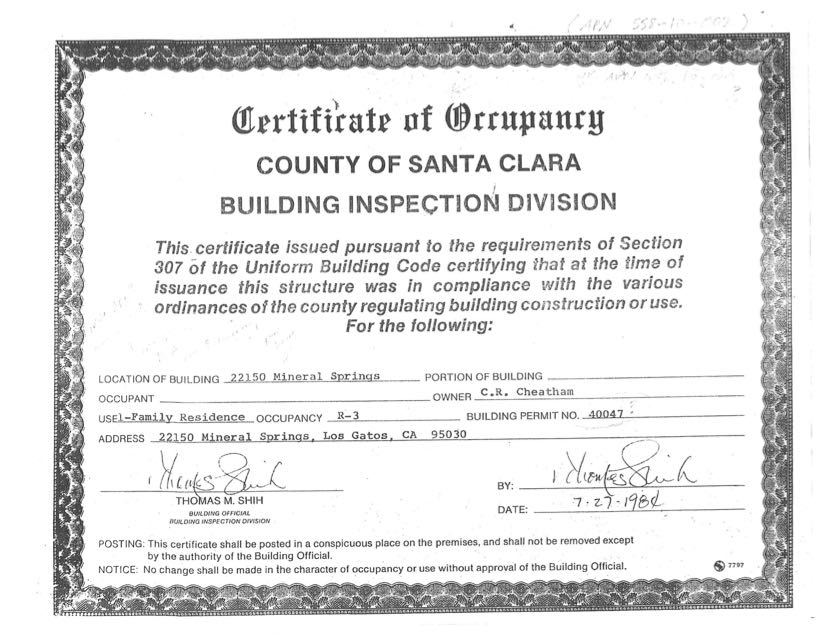
Cheatham told the Los Gatan he has no idea how the alterations and mistakes on the paperwork came to be. He admits he did some work he never got permits for, but he says, at the end of the day, the County put its stamp of approval on both of these Call of the Wild residences.
“They’re off in left field,” he said. “Talking about the house across the street (from where French lives) is an absolute waste of time. All that does is create a smokescreen that makes the County happy, in my mind.”
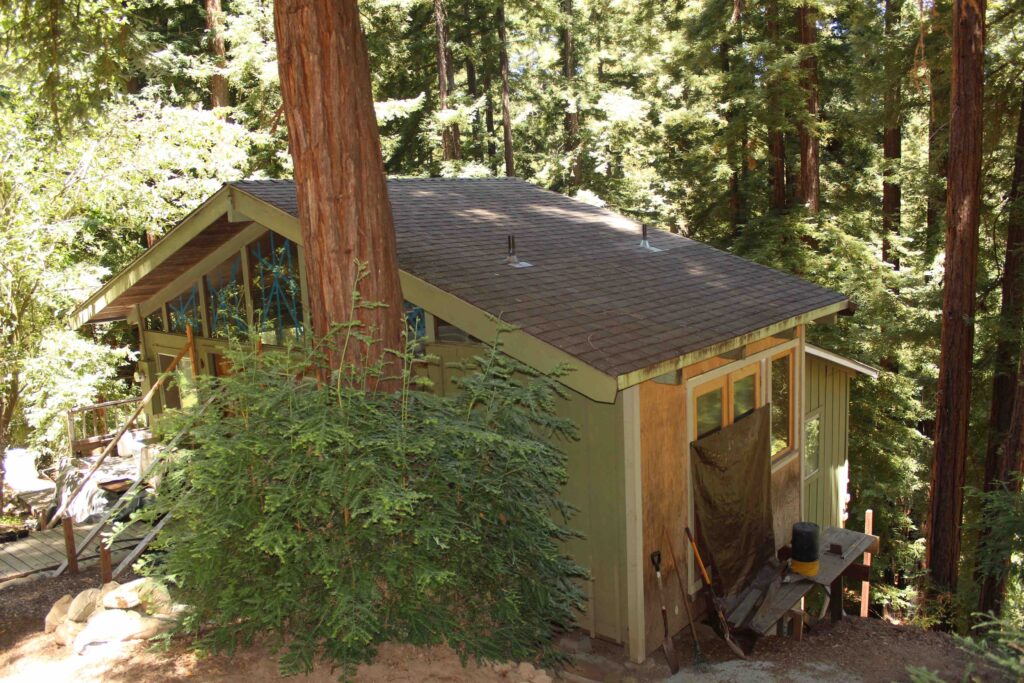
And the reality that the County is relying on a questionable violation notice to threaten French with thousands of dollars in fines doesn’t make sense to him.
“They will not stick to the facts,” he said. “She’s getting railroaded by the County.”
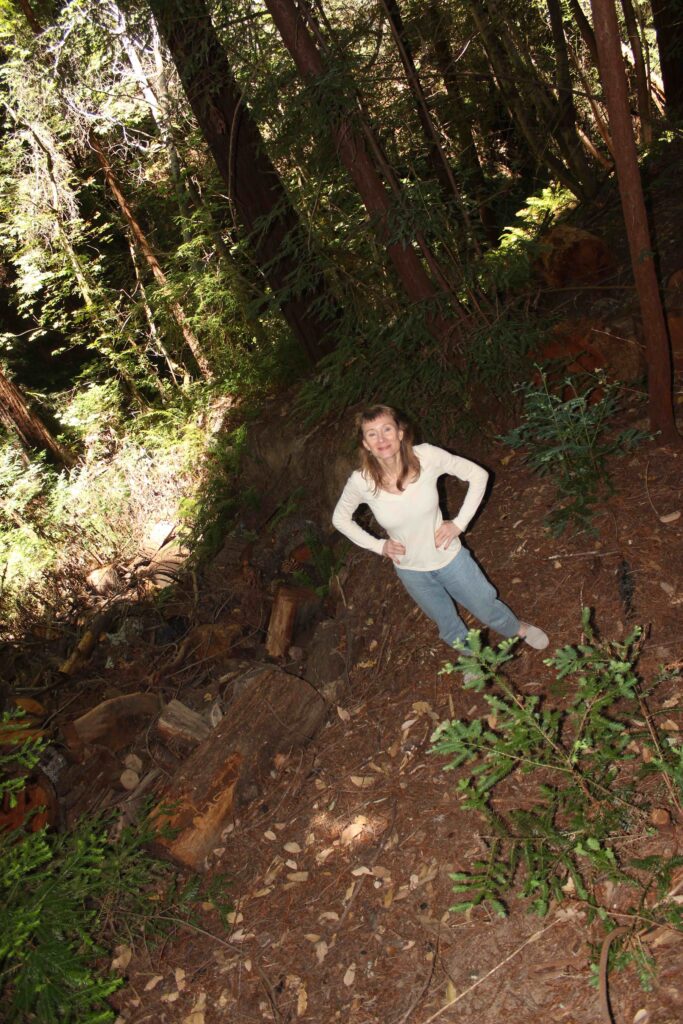
*Due to typos in an earlier edition, the permit number on the Certificate of Occupancy and the date of the new well completion were misstated. These have been corrected.










